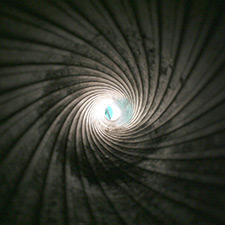Home | Glossary | Resources | Help | Contact Us | Course Map
Archival Notice
This is an archive page that is no longer being updated. It may contain outdated information and links may no longer function as originally intended.
Rifled Barrels
Spiraled grooves (rifling) are machined on the inner surface of a barrel for the purpose of spin-stabilizing the ball or bullet. This determines whether a long arm is a musket or a rifle. True muskets are smoothbore; rifling qualifies the firearm as a rifle. Early rifles were often called rifled muskets and are described in historical documents dating to 1500.
Smoothbore muskets offered ease and speed of loading whereas the rifle required more time for loading. The armies of Europe felt no need for slow loading when volley fire was ordered. These rifled arms required either special balls that were preformed to mate with the rifling in the bore or a mallet to start a conventional ball into the rifling.
Early experiments with rifled bores demonstrated that the basic round lead ball could be shot more accurately when spun. Much credit for the improvement of rifled arms is given to European immigrants to the North American colonies. German and Swiss immigrants found the arms that they brought with them were poorly suited to the American frontier. By 1700, fine-rifled arms were being made in quantity in Pennsylvania and other colonies.
A Permission is granted to copy, distribute and/or modify this document under the terms of the GNU Free Documentation License, Version 1.2 or any later version published by the Free Software Foundation; with no Invariant Sections, no Front-Cover Texts, and no Back-Cover Texts.
Projectiles
In addition to other modifications to improve their guns, Pennsylvania gunsmiths introduced the use of tallow-soaked cloth or buckskin patches to wrap around the ball. The ball could be smaller than any internal portion of the barrel; the patch made up the size difference. An undersized ball in a lubricated patch could be easily seated with a standard ramrod. The patch pushed powder fouling from previous shots back down the barrel, leaving the bore cleaner for the next shot. The texture of the tight-fitting patch provided the necessary friction to grip and spin the ball as it sped down the barrel. The patch also ensured that most of the powder gas remained behind the bullet.
In theory, a sphere should travel through air equally well with or without spin stabilization. In practice, as soon as the propellants pressure wave acts upon the soft lead ball, it is deformed into a stubby cylinder. In-bore deformation of a projectile by firing pressure is called slugging. By their nature, cylinders require artificial stability; this is provided by the spin imparted by rifling.
Shotguns
The development of rifling gave rise to the dedicated shotgun. With the powder charge in place, a smoothbore musket could be loaded with almost any reasonable projectile. For small game hunting, a cloth wad with a charge of tiny lead pellets ( bird shot) could be inserted. For larger targets at closer ranges, multiple large pellets ( buckshot) could be used. For the largest game or human targets (military or civilian), a large single ball was also effective.
Multiple pellets fired down a rifled bore spin into patterns that disperse faster than charges from a smoothbore, effectively reducing the range for shotgun targets. A rifle shooter also needed a shotgun for birds and other fast-moving game. Consequently, the rifle and shotgun diverged into two distinct classes of firearms.
Historically, the rifles contribution is most often identified with the American Revolution. Although Washingtons regulars were armed with flintlock muskets, the irregulars were militiamen who fought using their Pennsylvania long rifles. From a position of cover, a single rifleman could deliver effectively aimed fire (usually at British officers exercising command).
Rifles were issued to military units on a small scale throughout history. Until projectiles were improved, rifles were not generally issued and accepted. In spite of the militarys reticence towards the rifled arm, they were widely used by hunters and target shooters.
Additional Online Courses
- What Every First Responding Officer Should Know About DNA Evidence
- Collecting DNA Evidence at Property Crime Scenes
- DNA – A Prosecutor’s Practice Notebook
- Crime Scene and DNA Basics
- Laboratory Safety Programs
- DNA Amplification
- Population Genetics and Statistics
- Non-STR DNA Markers: SNPs, Y-STRs, LCN and mtDNA
- Firearms Examiner Training
- Forensic DNA Education for Law Enforcement Decisionmakers
- What Every Investigator and Evidence Technician Should Know About DNA Evidence
- Principles of Forensic DNA for Officers of the Court
- Law 101: Legal Guide for the Forensic Expert
- Laboratory Orientation and Testing of Body Fluids and Tissues
- DNA Extraction and Quantitation
- STR Data Analysis and Interpretation
- Communication Skills, Report Writing, and Courtroom Testimony
- Español for Law Enforcement
- Amplified DNA Product Separation for Forensic Analysts


